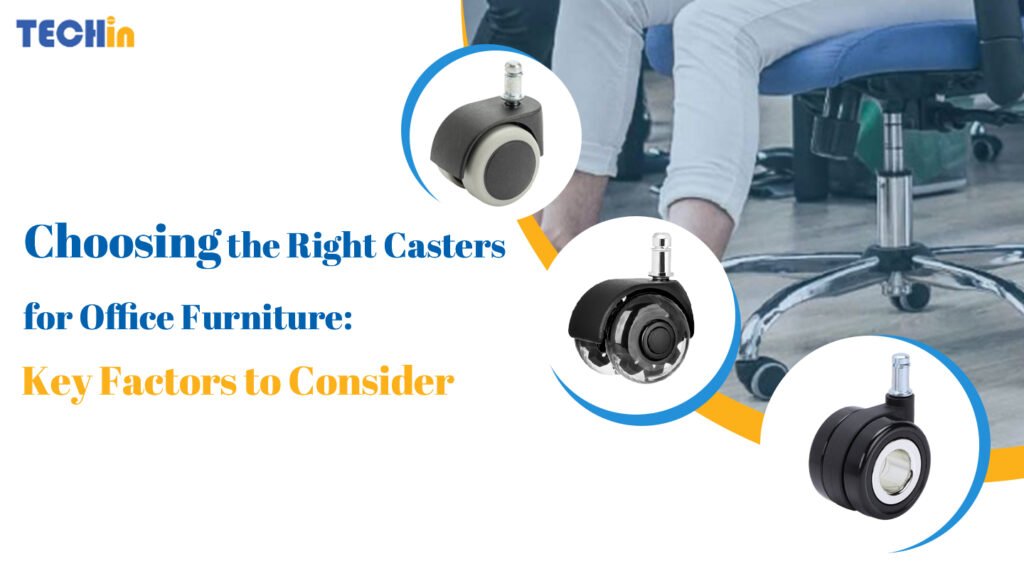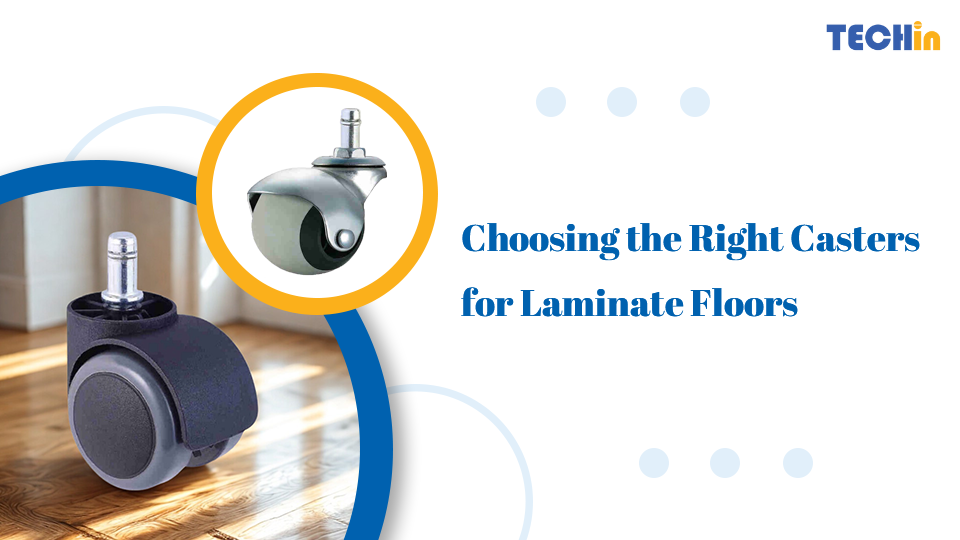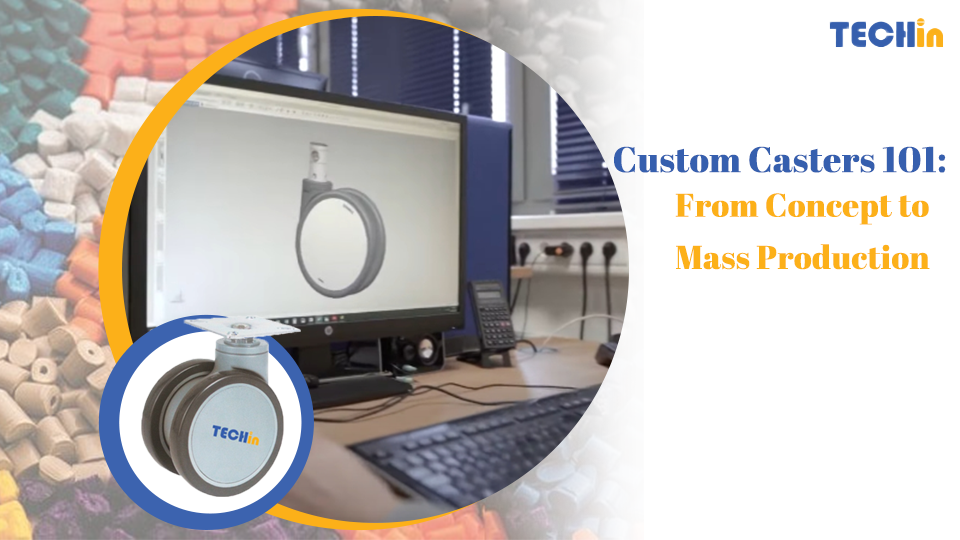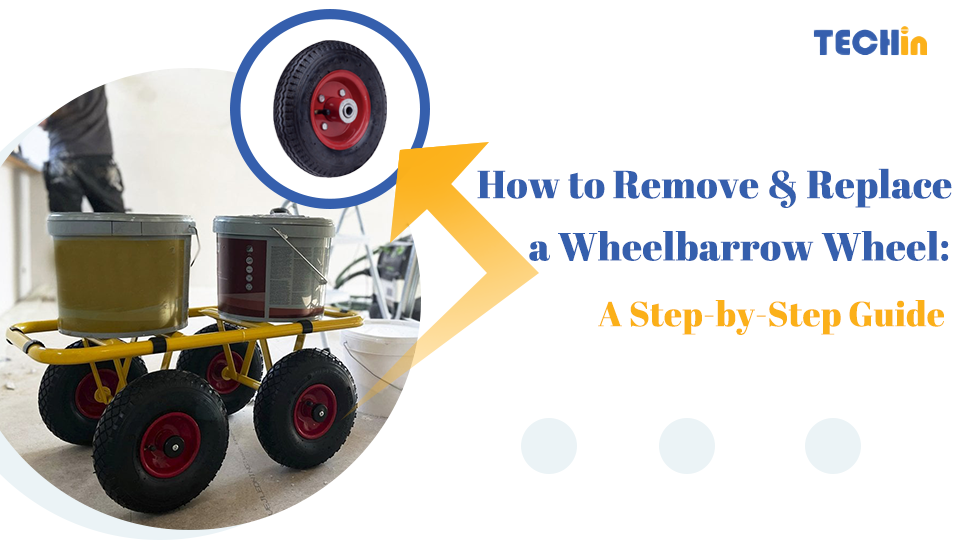Choosing the wrong caster is a mistake that can cost you—in damaged floors, broken equipment, or just daily frustration. It’s a detail that’s often overlooked, but getting it right from the start saves a lot of trouble down the road. This guide is here to give you the essential information, whether you’re buying for a large-scale fit-out or a single home office. We’ll cover what you need to know to make a confident, correct decision.
In short, the right casters for office furniture depend on six key factors: material, load capacity, floor type, noise level, safety features, and aesthetics. Use soft tread casters like polyurethane for hardwood or vinyl floors, and hard casters for carpet. Consider lockable casters for safety and choose styles that complement your office design.
Now, let’s dive into the details you need to master this, starting with the fundamentals.
What Are Furniture Casters?
Furniture casters are the wheels attached to the bottom of your office furniture—chairs, desks, cabinets, you name it. Their purpose is straightforward: to make heavy items mobile and your workspace adaptable. You’ll primarily encounter two types: swivel casters, which rotate 360°, and fixed casters, which only move in a straight line.
Think of them as the foundation of a flexible and ergonomic office. They’re a small component that has a massive impact on daily function.
How to Choose the Right Caster Wheels for Office Furniture?
Whether you’re a professional buyer sourcing thousands of units or an individual replacing a single set, the process is the same. It’s about more than just finding a wheel that looks right. Here is your checklist of the seven essential factors to consider for every purchase.
🔧 1. Caster Material
The wheel’s material is the most critical factor. It dictates how the caster performs on your floor, how loud it is, and how long it lasts. Here’s a quick reference:
| Material | Best For | Pros | Cons |
|---|---|---|---|
| Polyurethane | Hardwood, vinyl, tile | Quiet, floor-friendly, strong | Higher initial cost |
| Rubber | Laminate, concrete, tile | Absorbs shock, ultra-quiet, non-marking | Can wear more quickly under heavy loads |
| Nylon | Carpet | Highly durable, economical | Noisy and can scratch hard floors |
🔹 Pro Tip: For any modern office where noise is a concern, the choice is simple: avoid hard nylon or metal. Your best options will always be rubber or polyurethane for a quiet, smooth roll.
🏋️ 2. Load Capacity
Alright, let’s get straight to the most critical part. The single biggest mistake people make is underestimating the weight a caster needs to handle. You have to account for the total load—that’s the furniture plus everything you plan to put on or in it.
🔗 Not sure how to calculate that?
Don’t worry, you don’t have to guess. We built a simple tool to do the math for you:
👉 Caster Load Capacity Calculator
🧱 3. Mount Type: Stem vs Plate
The caster must be compatible with your furniture’s mounting point. This is a common point of failure for DIY replacements.
- Stem Casters: Use a single post for attachment. This is the standard for office chairs.
- Plate Casters: Use a flat plate with screw holes for attachment. These are for heavy items with a flat base, like cabinets.
📌 A critical detail: You must verify the stem size before buying replacements. Ordering the wrong one is a waste of time and money.
🔇 4. Noise Level
In a productive environment like an office, school, or hospital, noise from rolling furniture is a significant distraction.
- Rubber and Polyurethane casters are engineered for quiet operation on hard surfaces.
- Nylon and metal casters are inherently noisier and can be disruptive.
🔹 Tip: If silence is golden, your best investment is a soft tread caster with high-quality, sealed bearings.
🔐 5. Safety Features
Casters play a direct role in workplace safety by preventing unwanted movement.
- Brakes / Locking Mechanisms: Absolutely essential for any mobile furniture that needs to be stationary at times. Look for dual-locking casters, which lock both the wheel’s rotation and the swivel for maximum stability.
- Anti-static / Non-marking options: These are necessary for specialized environments with sensitive electronics or pristine floors.
Got it. Here is a more concise version, still in Yansir’s voice.
🎨 6. Aesthetic
Finally, let’s talk about looks. In a space designed to impress, the caster’s appearance is a detail you can’t afford to get wrong. It’s the finishing touch that pulls the entire design together.
- Chrome and brushed finishes give that polished, executive feel.
- Matte black or white is perfect for clean, minimalist designs.
- Transparent casters make furniture feel lighter and less cluttered.
🔹 Pro Tip: For a truly cohesive look, match the caster’s finish to the other hardware—the chair base, the desk legs.
How to Choose the Correct Material for Your Floorings
Let’s simplify this. The caster material should complement your floor type, not fight it.
| Floor Type | Recommended Caster Material |
|---|---|
| Hardwood / Vinyl Plank | Soft tread (polyurethane or rubber) |
| Carpet | Nylon or hard plastic casters |
| Tile / Concrete | Polyurethane or rubber with brakes |
| Laminate | Rubber (to prevent scratches) |
The principle is straightforward: soft wheels for hard floors to prevent damage, and hard wheels for soft floors to ensure easy rolling.
What Size Wheels Are Office Chair Casters?
For office chairs, wheels typically range from 2 to 3 inches in diameter. Here’s how to decide:
- 2-inch casters: Standard for basic chairs, best suited for hard floors or very low-pile carpet.
- 2.5 to 3-inch casters: A significant upgrade. They provide a much smoother roll, especially over carpet and small obstacles.
For better performance and ergonomics, larger wheels are almost always the better choice.
Do Caster Wheels Affect Office Safety?
Yes, absolutely. Improperly selected casters are a liability. They can lead to tipping, uncontrolled movement, and potential injuries. To mitigate risk:
- Use lockable casters on any furniture that needs to be stabilized, like standing desks.
- Never use hard metal casters on smooth, slick flooring.
- Ensure the caster’s load rating is more than adequate for the total weight it will support.
For most modern offices, lockable soft tread casters provide the best balance of safety and mobility.
How Important is Aesthetics When Choosing Casters?
In a well-designed space, every detail counts. The appearance of a caster can be the finishing touch that reinforces quality and style. Consider these options:
- Chrome or polished finishes for a modern, high-tech look.
- Matte black for a clean, minimalist design.
- Custom-designed casters that integrate seamlessly with a specific furniture collection.
It’s a small element, but it has a big impact on the overall impression of the product, especially in a showroom or executive setting.
Conclusion
You are now equipped to choose the right casters with confidence. Getting this right means protecting your assets, ensuring safety, and creating a more efficient workspace.
If you have a unique challenge or further questions, our team is here to help. Drop a comment or contact us directly for expert advice.









